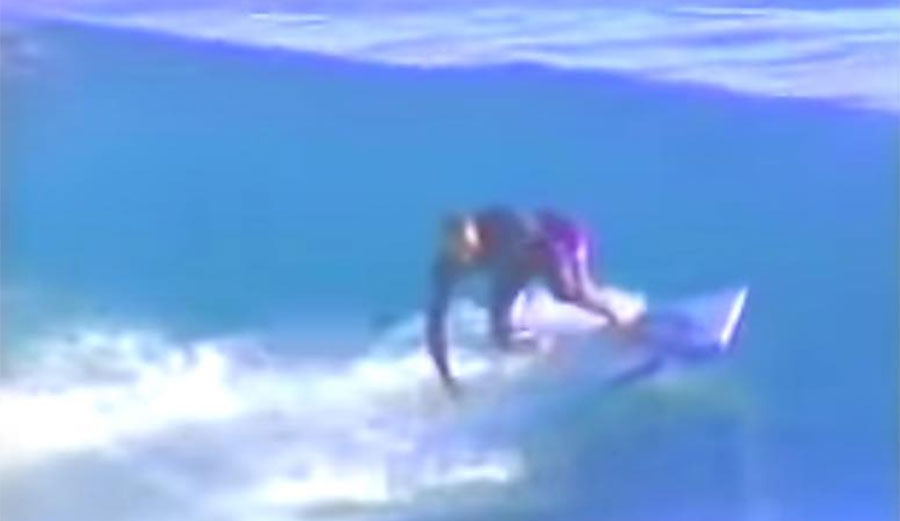
This is a screenshot from one of our early movies. Todd Chesser was filming in West Oz. This is the end of a wave. Take-offs were steep, double overhead. Early in the session, he broke almost two feet off the front of his board. Neva’ mind. Keep charging! Didn’t faze him one bit. Kept tearing it up for another two hours. Photo: Rusty Surfboards
Editor’s Note: This feature was made possible by our partners at Rusty Surfboards.
Your board is not right? I can’t tell you how many times, early in my surfing career that the boards I ordered and the boards I received were very different. Virtually every single one. Was I bummed? Fuck no! I was so psyched to have a new board and I couldn’t wait to wax it up and get it wet.
In 1966, I bought my first used board. It was a 9’0″ Ekstrom Asymetrical. I bought it for $30 and paid $60 to have the nose fixed. I was so out of my mind with the board. In hindsight, I really had no base of reference. I am a goofy foot. It was designed for a light regular foot, but I freaking loved that board.
My first new, custom board was an 8’10″ Twin Pin. All the best surfers in La Jolla were riding them. I was new to surfing, but I got in the water nearly every day.
It was right at the beginning of the shortboard revolution. Surfboards La Jolla’s Bear Mirandon shaped it. Bear happened to be large — maybe a bit bigger than me. I was 6’4″, 190 at the time, so he could relate to a larger surfer. He surfed pretty well and was a visionary shaper. He was actually the link between Bob Simmons and Steve Lis. Steve walked into the Mirandon Brothers shop at the top of Tourmaline and absolutely tripped out on their Twin Pins, Twin Fins. Twin Pins were Steve Lis’ inspiration.
My next board, I had to earn the money. I got a job as a bagger at Mayfair Market for two dollars an hour. Gas was 20 cents a gallon. New boards were $200. Gas these days is five dollars a gallon, up by a factor of 25. New boards now are $900 plus. That is a factor of five, maybe. So please, don’t ask for a deal and then complain that your logo was a little high.
I worked all summer and put a deposit down in June. I finally got the board in September. It was a 7’6″ Twin Pin with none of the characteristics of the 8’10″. I said to myself, “Shoot, I’ll give this thing a try.” I struggled and struggled with it for a few months and came to a conclusion about the board: I had basic skills, but I could tell that this board was a pig.
Even after I had started shaping, I went through a long list of shapers for several years. I would get boards from big-name shapers to try and understand more about design. None of the boards came out as expected. Some close. Many were not so close.
Nonetheless, I was always stoked to get a new board and enjoyed riding every single one of them. Some more than others. Bottom line, I always took away some info about how different designs performed in the water. Color? Forget it. Something ordered blue and black would come out orange and red. I abhorred the thought of other surfers thinking I was more about my board matching my board shorts than how it actually performed.
We have so many repeat customers who buy multiple boards a year. They trust me. Not only do they come back over and over again, but they also send their friends in. Surfboards are handmade. Eight-plus hours of skilled labor goes into each and every one. But try as hard as we do, they rarely turn out perfect.
I will take any board, one of mine, or any other top board builder, and I can point out flaws. Design is one thing. I’m not talking design. I’m talking cosmetics. From time to time, shit happens. Usually, it’s cosmetic and will in no way affect the way the board performs. So, unless it’s a serious structural issue, wax it up and give it a chance… You might be pleasantly surprised.
For more insights from Rusty Preisendorfer, check out Why Your Surfboard Shouldn’t Be Bulletproof and Surfboard Volume: Rusty Preisendorfer Breaks Down Everything You Need to Know. See more from Rusty on Rustysurfboards.com, on Facebook, Instagram, and YouTube.

